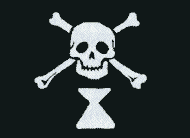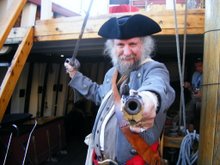Have you ever noticed how few pirate movies actually feature acts of piracy? Here's an example of what I mean.
Pirates of the Caribbean I - Barbossa and the crew of the Black Pearl are proper pirates. We get our first glimpse of the Pearl as having just sunk a merchant ship. Later the crew of the Pearl sack Port Royal. But what of Jack Sparrow? We first see him in a leaky boat. He admires the Interceptor then rescues Elizabeth and is arrested for past charges. While a list of charges is read at his hanging, we never see him doing anything that deserves a death sentence except possibly the commandeering of the Interceptor (which Will was pardoned for). In fact, this is a sore point for the crew in the second movie. They are hoping for "something shiny". It appears that Jack hasn't been much of a pirate captain which would be why they abandon him at the end of the third movie.
Will and Elizabeth are arrested for helping pirates (specifically Jack). Will commands various ships and Elizabeth becomes the pirate king but neither actually practices any piracy (except for the Interceptor).
What about the prototype pirate, Long John Silver? He certainly had some disreputable deeds in his past but, like Jack, we don't see much of them. When he first appears he is a tavern owner who signs on as ship's cook. He does lead a mutiny but that is different from piracy.
Captain Morgan on Cutthroat Island is another pirate who is wanted for past, mainly unexplained deeds, but is currently engaged in treasure hunting rather than piracy.
If you want a real pirate then look to Captain Blood. Even here he has to have justification so we see him torn from his medical practice for helping a rebel and sold as a slave. From there his only alternative is escape and piracy. Even here he is a moral pirate, mainly attacking the evil Spanish and eventually being pardoned.
There is a simple reason for all of this. We are meant to sympathize with the pirates so their harsher nature is hidden. It's hard to root for someone while he's robbing and torturing the innocent. Of course, this hides a lot of the real nature of pirates. We end up with guys in tricorns who say "arr" a lot and spend their time looking for buried treasure.
Tuesday, June 17, 2008
Tuesday, June 3, 2008
Taking the helm
Being at the whipstaff of the Half Moon was enlightening.
For those who are not familiar with the whipstaff, it was used to steer large ships during most of the 16th and 17th centuries. As recently as Columbus, ships had a single deck and were steered with a tiller. When additional decks were added, they added the whipstaff. The whipstaff it a pole with a collar that attaches to the tiller. There is a pivot point where it goes through the upper deck. The person at the helm pushes the whipstaff which then moves the tiller. This was, the helmsman can see out (at least to the sides) and, more importantly, can hear commands.
The hard thing about the whipstaff is which way you move it. Anyone who has used a tiller is used to moving the tiller right to turn left. This is switched with the whipstaff. You push it to the left to turn left.
There is an effort to moving the whipstaff. Also, if you push it all the way to one side then it slides down through the pivot and you have to pull it back up to center it again. An hour at the whipstaff is tiring.
At times the captain simply gives orders about how the ship should be steered - left 1/4, right 1/2, etc. Other times he would point to a landmark in the distance and ask that this be kept close to the port or starboard. At sea the captain would give a compass heading and the helmsman would use the compass in the binacle which is right in front of him. At these times he doesn't even need to see out.
The captain pointed out that the tiller doesn't really move much - maybe 15 degrees each way. The tiller acts more as a trim tab. The real work in turning the ship is done with the sprit sail and the mizzen. These pull the front or back the ship around.
The ship's wheel was invented around 1690 and became popular in the early 18th century. It had cables that went to the tiller. Turning the wheel pulls the cables, moving the tiller right or left. This has several advantages. The wheel can be mounted higher. Because of ratios, it cam make turning the ship easier. It can pull the tiller further to either side. And, it can be tied off as needed.
Regardless, steering the ship was not something that a captain normally did. In a tricky situation the captain would want to be mobile rather than stuck at one spot.
For those who are not familiar with the whipstaff, it was used to steer large ships during most of the 16th and 17th centuries. As recently as Columbus, ships had a single deck and were steered with a tiller. When additional decks were added, they added the whipstaff. The whipstaff it a pole with a collar that attaches to the tiller. There is a pivot point where it goes through the upper deck. The person at the helm pushes the whipstaff which then moves the tiller. This was, the helmsman can see out (at least to the sides) and, more importantly, can hear commands.
The hard thing about the whipstaff is which way you move it. Anyone who has used a tiller is used to moving the tiller right to turn left. This is switched with the whipstaff. You push it to the left to turn left.
There is an effort to moving the whipstaff. Also, if you push it all the way to one side then it slides down through the pivot and you have to pull it back up to center it again. An hour at the whipstaff is tiring.
At times the captain simply gives orders about how the ship should be steered - left 1/4, right 1/2, etc. Other times he would point to a landmark in the distance and ask that this be kept close to the port or starboard. At sea the captain would give a compass heading and the helmsman would use the compass in the binacle which is right in front of him. At these times he doesn't even need to see out.
The captain pointed out that the tiller doesn't really move much - maybe 15 degrees each way. The tiller acts more as a trim tab. The real work in turning the ship is done with the sprit sail and the mizzen. These pull the front or back the ship around.
The ship's wheel was invented around 1690 and became popular in the early 18th century. It had cables that went to the tiller. Turning the wheel pulls the cables, moving the tiller right or left. This has several advantages. The wheel can be mounted higher. Because of ratios, it cam make turning the ship easier. It can pull the tiller further to either side. And, it can be tied off as needed.
Regardless, steering the ship was not something that a captain normally did. In a tricky situation the captain would want to be mobile rather than stuck at one spot.
Sailing the Half Moon

I spent the weekend at the School of the Sailor on the Half Moon. This is a reconstruction of the ship Henry Hudson used in his 1609 voyage. Some of the photos I took are here. The official web site for the event is here.
I got to do some things that most pirate reenactors never do - I spent a weekend living on a 17th century ship, working the sails, and taking the helm (I spent two 1-hour shifts at the whipstaff).
In addition to sailing, we also did some live fire. I shot a dog-lock musket and an English-lock pistol. There was also a matchlock but I've live-fired my own. We also sang sea shanties and broke into smaller groups to concentrate on specific skills like navigation and knot work.
The event was educational.
The Half Moon is rated at around 100 tons (the size of the cargo hold) which is similar to the Santa Maria but it felt a lot smaller. The difference must be in the depth of the hold. I'm sure that the main deck on the Santa Maria is much larger than the weather deck on the Half Moon.
On the other hand, the Half Moon has an orlop deck which is where we slept.
The Half Moon would make a fairly decent pirate ship. It is fairly handy. It would require more guns. It only have a pair of 2-pounders and a pair of swivel guns.
It would also require cleaning up the ship's lines. The captain pointed out that the cabins present as much surface area to the wind as most sail boats. This makes it harder to steer. The wind can catch the rear of the ship and blow it sideways.
This part of the ship is there so that the captain and crew can live in some comfort. Pirates often removed these structures to improve their speed and maneuverability.
Subscribe to:
Posts (Atom)

